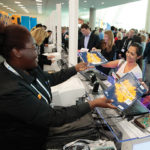In 2009, President Obama announced a six-year, $53-billion plan to develop high-speed rail in the United States, and suddenly, North America was a viable host destination for the International Union of Railways (UIC) World Congress on High-Speed Rail. Until then, the Paris-based UIC tended to meet in places with well-developed high-speed- rail programs, such as Japan, China, and Europe. UIC Highspeed 2010, for example, was held in Beijing, while Highspeed 2015 will be held in Japan.
KellyAnne Gallagher, director of member services for the American Public Transportation Association (APTA), was Fast Track involved in planning the Beijing conference when funding for the new U.S. program was announced. “APTA, who represents high-speed-rail interests in the United States, said, ‘Well, okay, there’s this new energy about high-speed rail – what would you think about hosting it in the United States next time around?’” Gallagher said. “And that’s how the conversation began. The UIC was thrilled, because they’d never been to the United States with a major event before.”
And that’s how the 8th World Congress on High-Speed Rail came to the United States this past summer.
High-speed Location
One thousand high-level officials, experts, and stakeholders in high-speed rail attended Highspeed 2012, which was presented by UIC and APTA in cooperation with the Association of American Railroads, Amtrak, the Federal Railroad Administration, and VIA Rail Canada – all UIC members – at the Pennsylvania Convention Center in Philadelphia on July 10–13. The theme, “High-Speed Rail: Connecting People, Building Sustainable Prosperity,” reflected the growing presence of high-speed rail in U.S. transportation-policy discussions – and not just at the national level.
Indeed, while Congress actually voted to defund Obama’s $53-billion plan in 2011, the California Legislature approved its own $7.9-billion plan just days before Highspeed 2012 got under way. There was even talk on the exhibition floor that as many as 200 of the conference’s attendees were walk-up registrants, and were a direct result of California’s decision.
Once it was determined that UIC would be bringing its biennial program to the newly relevant United States, figuring out when and where specifically to convene in 2012 became the first priority. “When the event was awarded to us, we went around talking to all of our industry partners, anyone else who has an interest in rail all around the world, to figure out when their events were in the 2012 cycle,” Gallagher said. “We didn’t want to come up against even our own [APTA] Rail Conference, which happens every June. … And because high-speed rail has been such a signature component of the [Obama] administration, we wanted to make sure it happened before the [presidential] election in November.”
APTA considered several destinations along the Northeast Corridor, stretching from Boston to Washington, D.C., because that’s where the United States has its only version of high-speed rail, in the form of Amtrak’s Acela Express service. “We moved to Philly, and they had the best package available for us,” Gallagher said. “They could handle our dates, the number of people we anticipated, and the amount of exhibit space.”
Philadelphia was a good fit for other reasons as well. “The [Pennsylvania] Convention Center is known for being part of Reading Terminal, which is one of the main [rail] hubs on the East Coast,” said Peter Horch, director of events at the Pennsylvania Convention Center. “The train station is part of the convention center and is actually where [UIC] had a lot of their events, in the old train shed, so to speak – which has, of course, been renovated.” Highspeed 2012 held its Gala Dinner, for example, in the soaring train shed, which was built in 1893 and has been renovated to become the convention center’s signature 30,000-square-foot Grand Hall ballroom.
Planning Across Borders
Other planning aspects of hosting a European-headquartered organization’s biennial event for the first time in the United States also presented challenges for APTA, which is based in Washington, D.C. Past Highspeed programs have been held in Beijing, Amsterdam, Milan, Madrid, Berlin, Brussels, and Lille, France; and U.S. organizers found that pulling together multiple international organizations forced them to adjust their schedules. “The biggest challenge, honestly, was the time difference,” Gallagher said. “UIC is six hours ahead of us, so oftentimes we were doing our conference calls with them at the crack of dawn for us, or very late in the day for them. But so much happens over email, and a core group of people did some traveling back and forth to do some planning.”
Time difference aside, both APTA and UIC, along with Netherlands-based conference-organizing group Europoint, worked well together to ensure a successful event. While it’s standard for one planning company to manage all the details, even for a large-scale event, Horch noted, the three organizations did a good job of handling site inspections, including at the main Amtrak hub at Philadelphia’s 30th Street Station, where the event’s opening reception was held. “Most of the folks who run the event are from Europe,” Horch said. “But when APTA got involved, it looked like a great partnership between the two organizations. … It’s all in the planning, so of course that’s where the details are. The event went extremely smooth.”
Train-ing Days
With event organizers, presenters, attendees, and exhibitors drawn from 37 different countries, Highspeed 2012’s general sessions featured a range of international speakers, including Yoshio Ishida, chairman of UIC and corporate auditor of East Japan Railway Company; Michael P. Melaniphy, president and CEO of APTA; and U.S. Secretary of Transportation Ray LaHood. High-level topics included a general session on the current state of high-speed rail around the world, while breakout sessions zeroed in on topics such as noise and vibrations, signaling and traffic management, economy and finance, and customer satisfaction. Roundtable discussions and debates between high-speed-rail leaders rounded out Highspeed 2012’s education program – which involved a total of 190 speakers.
“With each World Congress, UIC’s objective is to offer the very unique opportunity to share latest developments, successful strategies, and innovative technologies that have made high-speed rail an economic, environmental, and critical success,” Gallagher said. “[And] APTA’s objective in bidding to host the event was to bring that collective wealth of knowledge to an audience of transportation authorities that have the mandate and federal funding to develop high- and higher-speed rail systems throughout the U.S.”
The sheer number of high-speed-rail experts in attendance – including 32 directors and CEOs from rail companies worldwide – helped ensure top-notch education. “I think one of the unique things is the way they set their general sessions,” Horch said. “They spent a lot of time in general session, with a large number of people at the main stage discussing a lot of their topics. Their breakout sessions were very well attended also, but the general sessions were where they did an awful lot of business.”
UIC Highspeed 2012 also featured the world’s largest trade exhibition dedicated to high-speed-rail equipment, infrastructure products, and services. More than 80 exhibitors from 12 different countries participated; UIC estimated that the entire show drew nearly 3,000 visitors. The show floor itself spanned nearly 25,000 square feet, with exhibitions from a variety of companies. For example, Alstom Transport, a major U.S. and worldwide rail supplier, set up models of trains such as the Euroduplex, a double-decker train that has been operating on the Rhine-Rhône line in France since December 2011. There were also exhibitions featuring full-scale train interiors, technology demonstrations, and multimedia presentations, including one by the Japan California High Speed Rail Consortium that required 3-D glasses.
“I give a lot of credit to the show’s decorator, Freeman,” Horch said, “and also to UIC and APTA. I think over 80 percent of the [exhibitors] were international trade-show folks. … In that sense, more international than we’ve ever seen on the show floor.”
In addition to the events that took place inside the Pennsylvania Convention Center, Highspeed 2012 featured a series of site and technical tours, including trips to Amtrak’s Sunnyside Yard in Queens, N.Y., and to Wilmington Station in Delaware, which was built in 1907 by the Pennsylvania Railroad. Some attendees also visited the Southeast Pennsylvania Transportation Authority’s (SEPTA) operations control center in Philadelphia, which dispatches all modes of public transportation in the area.
“Philadelphia was a phenomenal host,” Gallagher said, “and I was just so proud of everything that the CVB and the local transit agency [SEPTA], which is a member of APTA, and Amtrak – everything that everyone in that city did to make Philadelphia shine for international guests.”
Sidebar: Was Highspeed 2012 Derailed?
Funding for high-speed-rail projects in the United States is contentious. While states like California have recently approved money for their own programs, and the issue received a high-profile push from President Obama at the beginning of his administration, governors in Florida, Ohio, and Wisconsin just last year rejected federal funding for the development of individual high-speed-rail programs in their states based on their estimates of low ridership and cost overruns.
What did it mean for high-speed rail’s premier industry event to convene in the United States for the first time in such a divisive climate? Peter Horch, director of events for the Pennsylvania Convention Center, which hosted the 8th World Congress on High Speed Rail, thought it was a good thing. “[California’s decision] boosted attendance even more, boosted a lot of local attendance,” Horch said. “It brought a lot of the other European transportation secretaries over to take a look at things – and in fact [the United States’] transportation secretary was here to open the show.”
Horch also said that he didn’t notice a lot of polarization among organizers and attendees, nor did the controversy seem to affect the planning process. And while officials from APTA and UIC were hesitant to draw specific comparisons between the California vote and their planning efforts, Railway Age magazine reported that APTA head Michael Melaniphy did note “perhaps it influenced events in some small way.” In the same article, UIC Director-General Jean-Pierre Loubinoux was quoted as saying: “We were certainly fortunate, weren’t we?”
More Resources
For more information about UIC Highspeed 2012, visit uic-highspeed2012.com.



